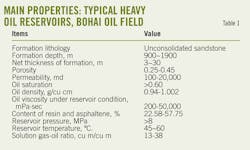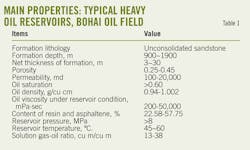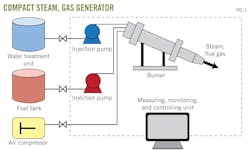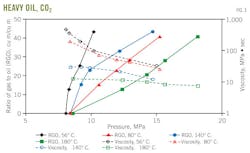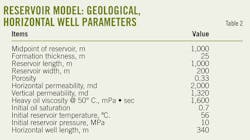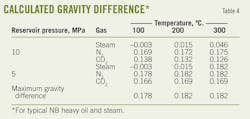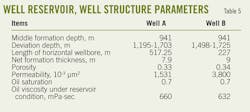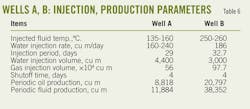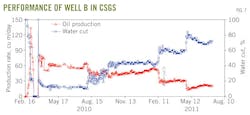Zhong Liguo
China University of Petroleum
Beijing
Sun Yongtao
China Oilfield Service Ltd. CNOOC
Tianjin
This article presents preliminary results of stimulation principles and offshore oilfield testing of cyclic steam and gas stimulation.
Heavy oil production from Bohai oilfield, using such cold-production processes as primary recovery and chemical flooding, has been limited. Such thermal processes as steam injection may enhance offshore heavy oil production.
The difficulty of installing a steam generator on a production platform has led China Oilfield Service Ltd. CNOOC to develop a compact steam and gas generator that is easy to install on a platform because of its separate units for water treatment, fuel injection, air compressor, and burner.
Generated high-temperature, high-pressure steam and flue gas can be used to stimulate the oil reservoir, reducing the oil viscosity by heating and by injecting gas, by enlarging the heat chamber, and by increasing pressure.
We have successfully applied cyclic steam and gas stimulation (CSGS) with a compact steam and gas generator to more than 10 wells in a typical Bohai offshore heavy oil reservoir. The field test results show that CSGS is practical for enhancing offshore heavy oil production. The oil production rate in the CSGS process can be three to five times that of cold-production methods.
Heavy oil in Bohai oilfield
Bohai oil field contains proven reserves of up to 4 billion tonnes (about 28.8 billion bbl).1 Typical heavy oil reservoirs include Lvda, Nanpu (NB), Suizhong, and Chengbei. Table 1 lists the main properties of these heavy oil reservoirs.
The reservoirs are usually deposited at 900-1,900 m with high initial reservoir pressures of more than 10 MPa (about 1,450 psi), making it difficult for conventional steam-injection processes.
A few heavy oil reservoirs have been produced by primary recovery and chemical flooding, but oil production has usually been limited to 10-25 cu m/day, and primary recovery has been lower than 5%~10% of original oil in place.1 These offshore heavy oil reservoirs, in other words, are not effectively produced by cold methods.
Therefore, the problem is to recover sufficient offshore heavy oil economically within the limited lifespan of the production platform.
Such steam injection processes as cyclic steam stimulation (CSS), steam flooding, and steam-assisted gravity drainage (SAGD) are the most effective methods and used worldwide to produce heavy oil. More than 60% of the world's EOR production employs steam injection. Among them, CSS is most widely used for its higher oil production rate, usually more than 2%/year original oil in place (OOIP) and extensive adaptability to reservoir conditions because of its single well operation and low technological and economic risk (OGJ, Apr. 19, 2010, p. 36).
Compact steam, gas generator
Considering the difficulty of installing a conventional large steam generator on a production platform and injecting steam into a deep reservoir at high pressure, we developed a compact steam and gas generator to enhance offshore heavy oil production. The unit consists of separate units for water treatment, fuel injection, air compression, and a burner (Fig. 1).
Water is injected into the outside of the burning chamber, and steam or hot water is generated by heat from the burning chamber. Heated steam or hot water is then mixed with flue gas at the outlet of the burning chamber. The composition of the generated high-temperature (usually 150-300 ºC.) and high-pressure (up to 20 MPa) steam and flue gas is 79-85% N2, 10-15% CO2, and a small amount of oxygen.
The produced steam and gas can be used to stimulate the oil reservoir by reducing the oil viscosity with heat and a gas solution, heat-chamber enlargement, and increasing pressure with gas injection.
Additionally, some chemicals are injected to inhibit corrosion and improve steam and gas injection conformance.
Stimulation principles
Most laboratory results, numerical simulations, and field applications of steam and gas such as CO2 flooding show that heavy oil recovery can be improved by reducing the viscosity with the gas solution and the solution gas-drive.2-7
Hong and Ault4 show that oil production can be accelerated with additional gas drive, and cumulative recovery is increased by the amount of heat injected. After breakthrough of CO2 or steam through a layer or channel, the gas becomes ineffective in aiding oil production. Coinjection of CO2 with steam can improve oil recovery over what is obtained with steam alone for oil without initial gas content. In other words, it was not beneficial to introduce CO2 to steam flooding for a reservoir with high initially dissolved gas.
Based on experimental results of Hornbrook et al, adding CO2 to steam improved the recovery rate of the West Sak crude oil sample used and resulted in lower injection temperature without reducing oil recovery as long as the injection temperature remained above the saturation temperature.7
The stimulation principles of coinjection of steam and gas, therefore, include reduction in oil viscosity by heating and gas solution, heat-chamber enlargement, pressure increase and gravity drainage assistance by coinjected gas, and a decrease in heat loss by the gas accumulation in reservoir.
Viscosity reduction
Figs. 2 and 3 show the relationship between the ratio of gas to oil (RGO) and viscosity of NB heavy oil and N2 or CO2 system and saturation pressure, respectively. It can be concluded that a less than 20% viscosity reduction for N2 is observed at different temperatures, and up to a 93.3% decrease in viscosity obtained for CO2 at 56 °C. ( initial reservoir temperature) and 48% decrease at 180 °C. and heavy oil viscosity decrease by CO2 solution is three to eight times that of N2, and larger viscosity decrease by gas solution is obtained at lower temperature.
Heat-chamber enlargement
Based on a simplified reservoir model with 50×40×25 grids and a 340-m long horizontal well, we conducted a numerical simulation of CSS and CSGS using the THERMAL simulator of ECLIPSE and the properties of reservoir model from NB heavy oil reservoir (Table 2). The horizontal well is at 17 m from the top of the reservoir.
The steam injection volume is 3,000 cu m, steam temperature 200 °C., steam quality 0, ratio of gas to water (RGW) at standard condition is 200 in the CSGS process. Fig. 4 shows the temperature cross sections of the horizontal well after steam injection in CSS. After steam and flue-gas coinjection in CSGS, the heat chamber volume in CSGS is 1.5-2 times that of CSS for such a reservoir with high pressure. At the same time, the temperature of the heat chamber in CSGS process is lower than CSS (Table 3).
Reservoir pressure increase
Fig. 5 shows the pressure cross-sections after steam injection and coinjection of steam and flue gas obtained from the numerical simulation, and Table 3 lists the estimated volume of pressurized chamber and average pressure increase. It could be concluded that larger pressurized volume is obtained by CSGS than CSS for the coinjected flue gas, and more pressure increase is observed as well.
Gravity drainage assistance
There was no consideration given for the gas solution in oil and water nor was the gravity difference for oil drainage calculated. Table 4 lists the typical gravity differences between oil and gas when the oil density is 950 kg/cu m and the formation thickness is 20 m. Negative values for steam indicate the steam is converted to water under higher pressure and lower temperature, and the gravity difference between water and oil push oil upward.
A larger gravity difference between N2 and oil is obtained compared with CO2 because of the compressibility difference. When the reservoir pressure is decreased to 5 MPa and 200-300 °C. N2 is injected, attaining maximum gravity difference up to 0.2 MPa.
Field testing
We have successfully applied CSGS to more than 10 wells in the NB offshore heavy oil reservoir. The steam and gas generator operated soundly, and oil production more than doubled the rate from a cold production process. Primarily, the application shows that CSGS technology is feasible and has the potential to enhance offshore heavy oil production.
Production performances of two typical stimulated Wells A and B are presented. Well A is an un-thermally completed horizontal well; Well B is a newly drilled and thermally completed horizontal well.
Table 5 lists the reservoir and well structure parameters of the two wells. Table 6 presents the injection and production parameters of Wells A and B. Figs. 6 and 7 show the production performance of Well A before and after CSGS and Well B in CSGS process.
Well A produced 8,818 cu m oil in 300 days by CSGS, the average oil production was 61 cu m/day (33.7 cu m/d more than before), the bottomhole flowing pressure was up to 9.1 MPa (4.6 MPa higher than before), and ratio of oil to steam (OSR) increased to 2.2.
Well B produced 20,797 cu m oil in 490 days by CSGS, the average oil production rate was more than 45 cu m/day, and the maximum oil production rate was up to 134 cu m/day. Compared with conventional cold production, in which oil production is usually lower than 25 cu m/day, a more than 8,547 cu m oil production increase was obtained.
Acknowledgments
The authors would like to thank National Natural Science Foundation of China, China National Petroleum Corp., and China Oilfield Service Ltd. (COSL) for their support of this work and also thanks to those who contributed to, researched, and reviewed this manuscript.
References
1. 2011 Oilfield Development Report of Tianjin subcompany of China National Offshore Oil Corp.
2. Redford, D.A., "The Use of Solvents and Gases with Steam in the Recovery of Bitumen from Oil Sands," JCPT, January-February 1982, pp. 45-53.
3. Leung L.C., "Numerical Evaluation of the Effect of Simultaneous Steam and Carbon Dioxide Injection of the Recovery of Heavy Oil," JPT, September 1983, pp. 1591-1599.
4. Hong, K.C., and Ault, J.W., "Effects of Noncondensable Gas Injection on Oil Recovery by Steamflooding," JPT, December 1984, pp. 2160-2170.
5. Stone, T., and Malcolm, J.D., "Simulation of a Large Steam-CO2 Coinjection Experiment," JCPT, November-December 1985, pp. 51-59.
6. Fraunfeld, T.W.J., Ridley, R.K., and Nguyen, D.M., "Effect of an Initial Gas Content on Thermal EOR as Applied to Oil Sands," JPT, March 1988, pp. 333-338.
7. Hornbrook, M.W., Dehghani, K., Qadeer, et al., "Effects of CO2 Addition to Steam on Recovery of West Sak Crude Oil," SPE Reservoir Engineering, August 1991, pp. 278-286.
Manuscripts welcomeOil & Gas Journal welcomes for publication consideration manuscripts about exploration and development, drilling, production, pipelines, LNG, and processing (refining, petrochemicals, and gas processing). These may be highly technical in nature and appeal or they may be more analytical by way of examining oil and natural gas supply, demand, and markets. OGJ accepts exclusive articles as well as manuscripts adapted from oral and poster presentations. An Author Guide is available at www.ogj.com, click "home" then "Submit an article." Or, contact the Chief Technology Editor ([email protected]; 713/963-6230; or, fax 713/963-6282), Oil & Gas Journal, 1455 West Loop South, Suite 400, Houston TX 77027 USA. |
The authors
Zhong Liguo ([email protected]) is an associate professor at the China University of Petroleum-Beijing. He was an associate professor at Northeast Petroleum University 2005-11. His primary research interests are enhancing heavy oil recovery by combining steam, gas, and chemicals, downhole electrical heating, and multiphase flow in wellbore and reservoir. Zhong Liguo holds a PhD (2005) in oil and gas field development engineering from Daqing Petroleum Institute. He is a member of the Society of Petroleum Engineers and the American Chemical Society.
Sun Yongtao ([email protected]) is an engineer at China Oilfield Service Ltd. CNOOC. His primary research interests are related to enhancing offshore heavy oil recovery by a combination of steam, gas and chemicals. Sun Yongtao holds a master's (2007) in oil and gas field development engineering from Daqing Petroleum Institute. He is a member of SPE.
